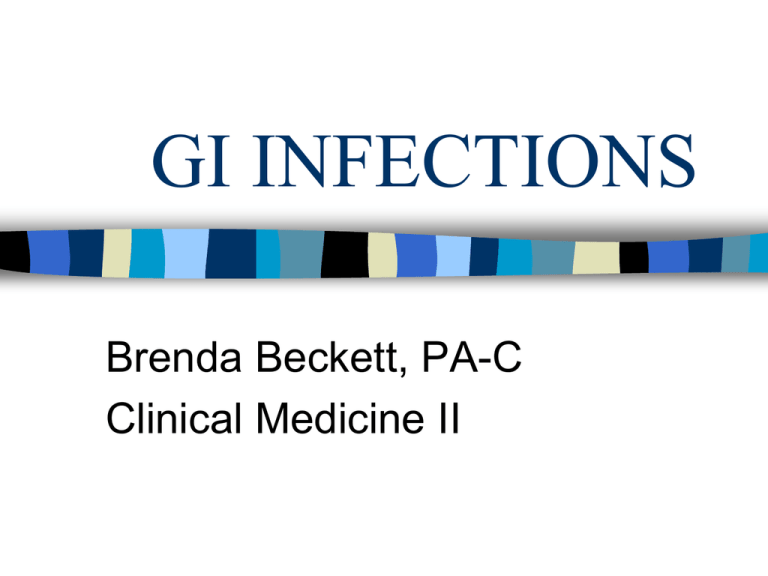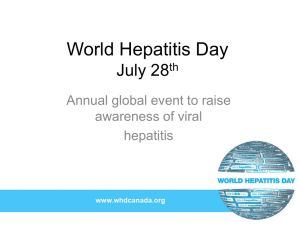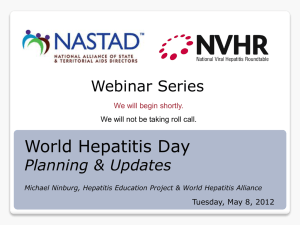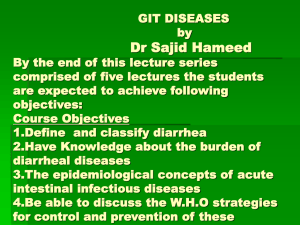
GI INFECTIONS
Brenda Beckett, PA-C
Clinical Medicine II
GI Infections
Gastroenteritis
Viral Hepatitis
Gastroenteritis
Diarrhea, vomiting, cramping
– Increased fluid output, more than 4-5,
watery bowel movements per day
Acute diarrhea – symptoms for less
than 2 weeks
– Exception: C. diff sx can last longer
Pathophysiology
Viruses damage the small intestinal villi,
decreasing intestinal surface area and
unmasking ongoing fluid secretion by
enteric crypts
Rotavirus produces an enterotoxin that
induces secretion and contributes to the
watery diarrhea
Pathophysiology
Invasive bacteria cause mucosal ulceration
and abscess formation with an inflammatory
response (WBCs in stool)
Bacterial toxins may influence enteric and
extraenteric cellular processes (HUS, etc)
Other noninvasive bacteria and protozoa
adhere to the gut wall, causing inflammation
Patient Evaluation
Duration of symptoms
Quantity (frequency of stools)
Quality (watery)
Fever
Hematochezia – visible blood in stool
S/S of dehydration
Other sx: N/V, abd pain, tenesmus, anorexia
Recent travel, recent abx use, hepatitis risk
Other family members sick?
Ability to take PO fluids
Physical Exam
Jaundice
Hydration status – check for signs of
dehydration
Stool Guaiac – occult blood
Abdominal tenderness, bowel sounds
Mental status
Oral Rehydration
Replace water, salt, sugars lost due to
diarrhea, vomiting
In mildly dehydrated patient, it is first
line therapy before IV rehydration.
Formulas are based on patient weight,
degree of dehydration
75 ml/kg over 4 hrs every 2 min
Enteric Illness, categories
Non-specific gastroenteritis
Gastroenteritis with bloody diarrhea
Extraintestinal illness
Non-infectious causes of GI symptoms
Nonspecific Gastroenteritis
Diarrhea without high fever or bloody
stool
May have: cramps, low grade fever,
headache, malaise, dehydration, N/V
Etiology: Viral (Norwalk-like viruses,
Rotavirus), protozoal (giardia, crypto),
foodborne toxins (S. aureus), traveller’s
diarrhea, noninfectious causes.
Gastroenteritis with bloody
diarrhea
Bloody stools with fever, +/- vomiting:
Consider Salmonella, Shigella,
Campylobacter (bacterial)
Bloody stools without fever: Could be
above or E. coli 0157:H7.
GI illness with Extraintestinal
Disease
Jaundice: Hepatitis A (we’ll get there in
a little bit)
Meningitis: Listeria, salmonella
Arthritis: Campylobacter, salmonella
Flaccid paralysis and cranial
neuropathies: C. botulinum (Botulism)
HUS: E. coli 0157:H7
Noninfectious causes of GI sx
Otitis media, Group A Streptococcal
infection, irritable bowel syndrome,
inflammatory colitis, stress,
medications, gallbladder disease, peptic
ulcer disease
Staphylococcal Food Toxin
S/S: Vomiting, severe cramping, low
grade fever, diarrhea (no blood in stool)
Incubation: VERY short – 30 minutes to
a few hours.
Complications: None, spontaneous
recovery
Diagnosis: No specific test available.
Clinical dx.
Staphylococcal Food Toxin
Treatment: Supportive – rest, hydration,
compazine or other antiemetic for persistent
vomiting
Origin: Toxin producing S. aureus strains,
usually from human skin, inoculate food,
multiply at room temp. Toxins not destroyed
by reheating.
Other toxin producing bacteria: Clostridium
perfringens, Bacillus cereus.
Staphylococcal Food Toxin
Prevention
– Decrease food handling
– Do not allow foods to sit at room temp. for
long periods
– Glove use by food handlers
– Exclude persons from food handling when
obvious skin infections are present.
Salmonella
Agent: Multiple subtypes of Salmonella
species (S. enteritidis, S. typhimurium are
most common)
Reservoir: Birds (chickens, turkeys), reptiles,
others
Occurrence: Common
Transmission: Undercooked meat/eggs,
cross contamination by meat juices,
unpasteurized milk, handling reptiles
Salmonella
Incubation: 6-72 hours (usually 10-12)
Diagnosis: Stool culture
Clinical: Diarrhea, often bloody, fever,
cramps, vomiting
Complications (elderly, immunocomp.):
Arthritis, meningitis, sepsis.
Treatment: Usually supportive. Quinolones if
severe or if immunocompromised.
Campylobacter
Agent: C. jejuni
Reservoir: Poultry, cattle, others
Occurrence: Common
Transmission: Undercooked poultry,
cross contamination, unpasteurized milk
Incubation: 3-5 days
Diagnosis: Stool culture
Campylobacter
Clinical: Diarrhea (often bloody), severe
cramps, fever, +/- vomiting
Complications: Arthritis, cholecystitis
Treatment: Quinolones or erythromycin
Prevention: Adequate cooking, kitchen
hygiene, pasteurization
E. Coli 0157:H7
Agent: As above
Reservoir: Cattle (and foods contaminated
with cow feces)
Occurrence: Less common than Salmonella
and Campy, but increasing
Transmission: Ingestion of undercooked beef,
cross contamination, unwashed contaminated
fruits & veggies, person to person, water
contamination. HIGHLY transmissible.
E. Coli 0157:H7
Incubation: 2-7 days
Clinical: Watery diarrhea progressing to
bloody diarrhea after a few days. Fever
usually absent. Cramps, vomiting.
Complications: 5-10% of kids younger
than 5 will develop HUS, a life
threatening multisystem disease. Can
occur in adults.
E. Coli 0157:H7
Diagnosis: Stool culture, toxin assay
Treatment: Supportive. Antibiotics
usually avoided (can increase HUS)
Prevention: Thorough cooking of ground
beef, avoid cross contamination with
beef juices, wash fruits/veggies,
pasteurization. Early diagnosis will
prevent person to person transmission.
Shigella
Agent: S. sonnei, S. flexneri, others
Reservoir: Humans
Transmission: Person to person,
foodborne, flies.
Clinical: Fever, bloody diarrhea,
cramps, vomiting. Patients often appear
toxic.
Diagnosis: Stool culture
Shigella
Complications: Sepsis, meningitis
Treatment: Quinolones, hydration
Communicability: Extremely high
Prevention: Early diagnosis and
isolation, hand washing, food and water
hygiene
Occurrence: Rare locally, high in third
world countries.
Clostridium difficile
Most common antibiotic associated
diarrhea- due to changes in colonic
bacterial fermentation of carbohydrates
Colitis associated with toxin produced
by C. diff.
Hospitalized, immunocompromised are
most susceptible
Clostridium difficile
Antibiotics disrupt the normal flora, C. diff.
flourishes (carried asymptomatically by 3-8%
healthy adults). Any abx can trigger, but most
common are: cephalosporins, penicillins,
clindamycin, flouroquinolones
Sx start during or after abx therapy, may be
delayed 8 weeks
Easily transmitted in hospital setting
Clostridium difficile
Toxins (A- enterotoxin & B-cytotoxin) have
effect on colon- secretes fluid, develops
pseudomembranes (discrete yellow-white
plaques), easily dislodged.
Diagnosed by C. diff toxins in stool. EIA rapid
toxin A & B.
Treat with Metronidazole 500 mg po tid x1014 d. D/c other abx if possible.
Infection control measures to reduce spread
in hospital settings.
Viral Gastroenteritis
Most common cause of infectious
diarrhea in US
Infect epithelium of small intestine
Diarrhea is watery
WBC’s and visible blood are rare
4 categories: Rotavirus, Claicivirus
(norovirus), Astroviurs, Enteric
Adenovirus.
Rotavirus
Most common cause of diarrhea in young
children
Highly contagious: fecal-oral.
Incubation 1-3 days, lasts 4-8 days
Dehydration and hospitalization common in
young children
Diagnose by EIA antigen in stool
Treat with oral rehydration or IV
Oral vaccine now available (controversial)
Calcivirus
Infect older children and adults
Nonspecific, self-limiting
Large water-borne and food-borne
outbreaks occur, fecal-oral
Incubation 24-48 hrs, lasts 12-60 hrs
No commercial tests to diagnose
Treatment supportive (oral rehydration)
Giardiasis
Agent: Giardia lamblia
Reservoir: Human and animal stool
Occurrence: Very common
Transmission: fecal-oral, contaminated
water or food
Incubation: 3-10 days
Giardiasis
Clinical: Persistent or recurring diarrhea,
bloating, cramps, steatorrhea (frothy fatty
stool), weight loss. No blood in stool.
Diagnosis: Ova and parasite slide or direct
antigen test.
Treatment: Metronidazole or other
antiparasitic
Prevention: Water filtration, avoid drinking
untreated surface water.
Traveler’s Diarrhea
Usually caused by endemic bacteria,
not one specific agent. Most common is
E. coli.
Usually benign, self-limiting
Prophylactic abx for immunocomp.
Treat with flouroquinolone if bloody
diarrhea and fever
Changing gears…
Hepatitis - Causes
Drugs: antihypertensives, statins,
antibiotics, others.
Toxic agents: acetaminophen, alcohol,
others.
Viruses: Hepatitis A (HAV), B (HBV), C
(HCV) commonly. Uncommon: EBV,
CMV, measles, rubella, etc.
Hepatitis – Clinical Presentation
Anorexia
Malaise
N/V
Fever
Enlarged, tender liver
Jaundice
Abnormal liver enzymes
Liver Function Tests
Serum Aminotransferases (ALT and
AST). ALT usually >8x upper limit of normal
Serum and urine Bilirubin. (Neither
sensitive nor specific for viral hepatitis)
Serum Alkaline Phosphatase
Additionally: LDH, GGTP, Albumin,
Prothrombin Time
Lab and Physical Findings
In viral hepatitis ALT is usually higher than
AST, as opposed to alcoholic hepatitis
Many people are entirely asymptomatic or
mildly symptomatic with jaundice
(especially HBV and HCV infections)
Children <6yrs with acute HAV infection are
usually asymptomatic, rarely jaundiced
Table p 238-239 Wallach.
Acute Viral Hepatitis
Any combination of: malaise, fever,
nausea, vomiting, abdominal pain or
fullness, diarrhea, myalgias, headache.
Can have +/- jaundice, dark urine
AND abrupt, dramatic elevation of
ALT/AST
Hepatitis serologies to diagnose,
discussed in lab lecture.
Hepatits A
Most common cause of acute viral hepatitis
Small RNA picornavirus
About 30 day incubation
Fecal-oral transmission
Epidemics or sporadic cases
Source: contaminated water, food (shellfish)
No chronicity, no carrier state
Hepatitis A
Most children asymptomatic, most
adults symptomatic
Low mortality
Excreted in feces up to 2wks before
illness, rarely after first week of illness
Only viral hepatitis causing spiking
fevers
Viremia intermittent
Hepatitis A Vaccine
Available since the mid 1990’s
Recommended for:
– children 12-23 months
– International travelers
– People who live or work where there are
outbreaks
– Some other high risk groups
Hepatitis A Treatment
Symptomatic treatment (rest, fluids, etc)
Avoid strenuous physical exertion,
alcohol and hepatotoxins
IG given to close contacts
Vaccination of close contacts
Hepatitis B
Second most common cause of acute
viral hepatitis
dsDNA Hepadnaviridae
Most complex hepatitis virus
Infective particle made up of viral core
plus an outer surface coat
Transmission: sexual, parenteral,
perinatal
Hepatitis B
Can become chronic (5-10% of acute),
may result in cirrhosis, hepatocellular ca
Often asymptomatic or nonspecific
symptoms
Incubation 6-12 weeks
If recover from HBV infection, will be
immune
Hepatitis B Vaccination
Available since the 1980’s
Routine childhood vaccine (3 doses)
– Given at birth to babies of HBsAg pos
mothers
Anti-HBs response
Other high risk groups
Post exposure prophylaxis: HBIG and
start vaccine
Hepatitis B Treatment
HBIG given within 7 days of exposure
Initiation of HBV vaccine series
Symptomatic treatment (rest, fluids, etc)
Avoid strenuous physical exertion,
alcohol and hepatotoxins
Hepatitis C
Single-stranded RNA flavivirus
6 major subtypes with varying genotypes
Primarily transmitted by blood
– Injection drug use >50% of cases
– Posttransfusion, hemodialysis, tattoos, body
piercing
– Sexual and vertical transmission uncommon, but
increased risk with multiple sex partners.
– HIV patients at increased risk
Hepatitis C
Incubation period: 6-7 weeks avg,
ranges from 2-26 weeks
Clinical illness often mild, asymptomatic
Chronicity common: >70%, may
progress to cirrhosis, carcinoma
Leading cause of liver transplant
No protective antibody response
Hepatitis C
Prolonged viremia
Aminotransferases will be elevated off
and on (can have ALT >7x normal)
Diagnose with Anti-HCV EIA
Hepatitis C Treatment
Interferon or peginterferon for 6-24
weeks decreases risk of chronicity
May reserve treatment for those that do
not clear virus in 3-4 months (monitor
HCV-RNA). Clearance more likely in
symptomatic than asymptomatic pts.
Liver transplantation in acute liver
failure
Hepatitis C
NO immunization
No post exposure prophylaxis
Chronicity common
Different genotypes respond differently
to therapy
Other Hepatitis Viruses
Hepatitis D (Delta).
– Due to ssRNA virus.
– Always associated with Hepatitis B.
– Acute or chronic.
– Often severe, high mortality.
Hepatitis E. Due to ssRNA virus.
– Rare, occurs in endemic areas.
Chronic Hepatitis
HBV – 5-10% of acute infections
HCV - >70% of acute infections
HDV – with HBV coinfection or
superinfection
Chronic Hepatitis
Elevated aminotransferases for more
than 6 months
May lead to cirrhosis, hepatocellular
carcinoma
Liver transplantation indicated for endstage disease





